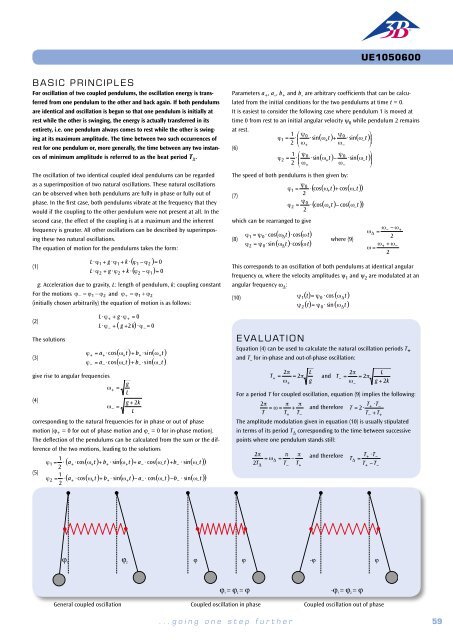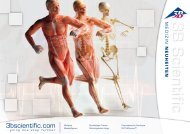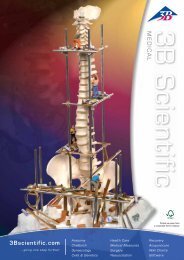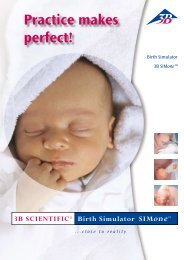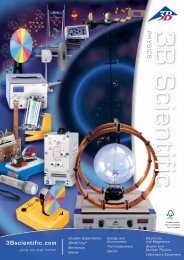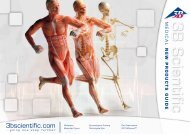3B Scientific - Physics & Engineering Experiments
3B Scientific - Physics & Engineering Experiments
3B Scientific - Physics & Engineering Experiments
You also want an ePaper? Increase the reach of your titles
YUMPU automatically turns print PDFs into web optimized ePapers that Google loves.
UE1050700<br />
Mechanics / Oscillations and waves<br />
Mechanical waves<br />
UE1050700<br />
superimposed on one another. If the other end is also fixed, the only<br />
way that waves can propagate is if resonance conditions are met.<br />
Let ξ(x,t) be the longitudinal or transverse deflection at a point x along the<br />
carrier medium at a point in time t. The following is then true:<br />
EVALUATION<br />
If resonant frequency is plotted against the number of nodes, the<br />
points will all lie along a straight line of gradient<br />
(1)<br />
This applies to a sinusoidal wave travelling from left to right along the carrier<br />
medium. The frequency f and wavelength λ are related in following way:<br />
Therefore, as long as the length L is known, it is possible to calculate<br />
the speed of propagation of the wave c. With all other parameters<br />
being equal it is dependent on the tensile force F, as Fig. 5 demonstrates<br />
for the waves along the rope.<br />
E X PERIMEN T<br />
PROCEDURE<br />
OBJECTIVE<br />
Investigate standing waves along a stretched coil spring and a taut rope<br />
(2)<br />
c: Propagation velocity of wave<br />
If such a wave, travelling from left to right, should be reflected from a fixed<br />
point at x = 0, a wave travelling from right to left direction then arises.<br />
(3)<br />
The two waves are then superimposed to create a standing wave.<br />
(x,t)<br />
x<br />
Fig. 1: Illustration of how the<br />
localised deflection ξ(x,t) is<br />
defined<br />
• Generate standing longitudinal waves<br />
in a coil spring and standing transverse<br />
waves along a rope.<br />
• Measure the intrinsic frequency f n as a<br />
function of number of nodes n.<br />
• Determine the corresponding wavelength<br />
λ n and speed of propagation of<br />
the waves c.<br />
SUMMARY<br />
Some examples of where mechanical waves arise include a stretched coil spring, where the waves are<br />
longitudinal, or a taut rope where the waves are transverse. In either case, standing waves will be set<br />
up if one end of the carrier medium is fixed. This is because the incoming wave and the wave reflected<br />
at the fixed end have the same amplitude and are superimposed on one another. If the other end is<br />
also fixed, the only way that waves can propagate is if resonance conditions are met. In this experiment<br />
the coil spring and the rope are fixed at one end. The other end, a distance L from the fixed<br />
point, is fixed to a vibration generator, which uses a function generator to drive small-amplitude oscillations<br />
of variable frequency f. This end can also be regarded as a fixed point to a good approximation.<br />
The intrinsic frequency of the vibration will be measured as a function of the number of nodes in the<br />
standing wave. The speed of propagation of the wave can then be calculated from this data.<br />
Required Apparatus<br />
(4)<br />
These considerations are valid regardless of the nature of the wave or of the<br />
carrier medium.<br />
If the other end is also fixed at a position x = L, then the following resonance<br />
condition needs to be fulfilled at all times t.<br />
(5)<br />
This only applies if the wavelength meets the following conditions:<br />
(6a) ,<br />
or<br />
According to equation (2), the frequency is then<br />
(6b)<br />
<br />
f<br />
n<br />
/ Hz<br />
50<br />
40<br />
30<br />
20<br />
10<br />
n = 0<br />
n = 1<br />
n = 2<br />
0<br />
0 2 4 6<br />
n<br />
Fig. 2: Standing waves<br />
Fig. 3: Resonant frequency as a<br />
function of the number of nodes<br />
for waves along a coil spring<br />
Quantity Description Number<br />
1 Accessories for Spring Oscillations 1000703<br />
1 Accessories for Rope Waves 1008540<br />
1 Vibration Generator 1000701<br />
1 Function Generator FG 100 (230 V, 50/60 Hz) 1009957 or<br />
Function Generator FG 100 (115 V, 50/60 Hz) 1009956<br />
1 Precision Dynamometer, 2 N 1003105<br />
1 Pocket Measuring Tape, 2 m 1002603<br />
1 Pair of Safety Experimental Leads, 75 cm, red/blue 1017718<br />
This implies that the condition for resonance (5) is only fulfilled if the<br />
length L is an integer multiple of half the wavelength. The resonant frequency<br />
must correspond to this wavelength. In this case, n is the number<br />
of nodes in the oscillation. This is zero if there is only one anti-node in the<br />
fundamental oscillation (see Fig. 2).<br />
In this experiment, the carrier medium is either a spring or a rope which<br />
is fixed at one end. The other end is connected to a vibration generator at<br />
a distance L from this fixed point. This uses a function generator to drive<br />
small-amplitude oscillations of variable frequency f. This end can also be<br />
regarded as a fixed point to a good approximation.<br />
f<br />
n<br />
/ Hz<br />
80<br />
70<br />
60<br />
50<br />
40<br />
30<br />
20<br />
10<br />
0<br />
0 2 4 6<br />
n<br />
c / m/s<br />
Fig. 4: Resonant frequency as a<br />
function of the number of nodes<br />
for waves along a rope<br />
20<br />
15<br />
1<br />
basic PRINCIPLES<br />
Some examples of where mechanical waves arise include a stretched coil spring or a taut rope.<br />
The waves arising in the spring are longitudinal waves since the deflection of the coil is in the<br />
direction of propagation. The waves along a rope by contrast are transverse waves. This is because<br />
the incoming wave and the wave reflected at the fixed end have the same amplitude and are<br />
10<br />
5<br />
0<br />
0 1 2<br />
F² / N²<br />
Fig. 5: Wave velocity c as a function<br />
of F² for the waves along<br />
a rope<br />
60 <strong>3B</strong> <strong>Scientific</strong>® <strong>Experiments</strong><br />
...going one step further<br />
61


